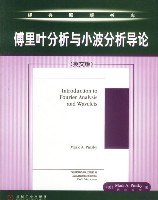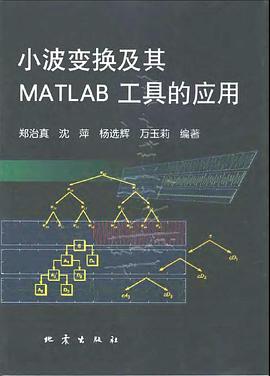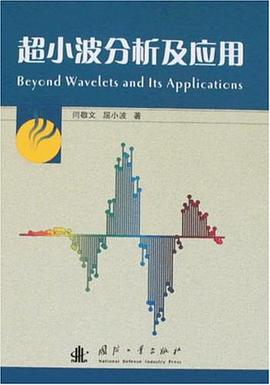

具體描述
本書是由一位成功的數學傢用傳統的錶述形式編寫的教材,除瞭主要介紹傅裏葉級數和傅裏葉分析外,還討論瞭另一類可以通過傅裏葉方法進行研究的正交級數,即小波分析。
本書可以作為理工類專業高年級本科生和低年級研究生的教材。
本書特點:
·書中的所有命題、引理、定理和推論都給齣瞭嚴格的證明
·某些情況下,對於一個給定的命題,給齣幾種證明方法,使學生可以對不同方法進行比較
·不屬於傅裏葉分析主流題材但與本書有特定聯係的論題,在帶有*號的小節中講述
·理論和實踐相結閤
著者簡介
圖書目錄
1 FOURIER SERIES ON THE CIRCLE
1.1 Motivation and Heuristics
1.1.1 Motivation from Physics
1.1.1.1 The Vibrating String
1.1.1.2 Heat Flow in Solids
1.1.2 Absolutely Convergent Trigonometric Series
1.1.3 *Examples of Factorial and Bessel Functions
1.1.4 Poisson Kernel Example
1.1.5 *Proof of Laplace's Method
1.1.6 *Nonabsolutely Convergent Trigonometric Series
1.2 Formulation of Fourier Series
1.2.1 Fourier Coefficients and Their Basic Properties
1.2.2 Fourier Series of Finite Measures
1.2.3 *Rates of Decay of Fourier Coefficients
1.2.3.1 Piecewise Smooth Functions
1.2.3.2 Fourier Characterization of Analytic Functions
1.2.4 Sine Integral
1.2.4.1 Other Proofs That Si( ) =l
1.2.5 Pointwise Convergence Criteria
1.2.6 *Integration of Fourier Series
1.2.6.1 Convergence of Fourier Series of Measures
1.2.7 Riemann Localization Principle
1.2.8 Gibbs-Wilbraham Phenomenon
1.2.8.l The General Case
1.3 Fourier Series in L2
1.3.l Mean Square Approximation-Parseval's Theorem
1.3.2 *Application to the Isoperimetric Inequality
1.3.3 *Rates of Convergence in L2
1.3.3.1 Application to Absolutely-Convergent Fourier
Series
1.4 Norm Convergence and Summability
1.4.1 Approximate Identities
1.4.1.1 Almost-Everywhere Convergence of the Abel
Means
1.4.2 Summability Matrices
l.4.3 Fejer Means of a Fourier Series
1.4.3.1 Wiener's Closure Theorem on the Circle
1.4.4 *Equidistribution Modulo One
1.4.5 *Hardy's Tauberian Theorem
1.5 Improved Trigonometric Approximation
1.5.1 Rates of Convergence in C(T)
1.5.2 Approximation with Fejer Means
1.5.3 *Jackson's Theorem
1.5.4 *Higher-Order Approximation
1.5.5 *Converse Theorems of Bernstein
1.6 Divergence of Fourier Series
1.6.1 The Example of du Bois-Reymond
1.6.2 Analysis via Lebesgue Constants
1.6.3 Divergence in the Space L1
1.7 *Appendix: Complements on Laplace's Method
1.7.O.l First Variation on the Theme-Gaussian
Approximation
1.7.0.2 Second Variation on the Theme-Improved Error
Estimate
1.7.l *Application to Bessel Functions
1.7.2 *The Local Limit Theorem of DeMoivre-Laplace
1.8 Appendix: Proof of the Uniform Boundedness Theorem
1.9 *Appendix: Higher-Order Bessel functions
1.10 Appendix: Cantor's Uniqueness Theorem
2 FOURIER TRANSFORMS ON THE LINE AND SPACE
2.1 Motivation and Heuristics
2.2 Basic Properties of the Fourier Transform
2.2.l Riemann-Lebesgue Lemma
2.2.2 Approximate Identities and Gaussian Summability
2.2.2.1 Improved Approximate Identities for Pointwise
Convergence
2.2.2.2 Application to the Fourier Transform
2.2.2.3 The n-Dimensional Poisson Kernel
2.2.3 Fourier Transforms of Tempered Distributions
2.2.4 *Characterization of the Gaussian Density
2.2.5 *Wiener's Density Theorem
2.3 Fourier Inversion in One Dimension
2.3.1 Dirichlet Kernel and Symmetric Partial Sums
2.3.2 Example of the Indicator Function
2.3.3 Gibbs-Wilbraham Phenomenon
2.3.4 Dini Convergence Theorem
2.3.4.1 Extension to Fourier's Single Integral
2.3.5 Smoothing Operations in R1-Averaging and Summability
2.3.6 Averaging and Weak Convergence
2.3.7 Cesaro Summability
2.3.7.1 Approximation Propenies of the Fejer Kernel
2.3.8 Bemstein's Inequality
2.3.9 *One-Sided Fourier Integral Representation
2.3.9.1 Fourier Cosine Transform
2.3.9.2 Fourier Sine Transform
2.3.9.3 Generalized h-Transform
2.4 L2 Theory in Rn
2.4.1 Plancherel's Theorem
2.4.2 *Bernstein's Theorem for Fourier Transforms
2.4.3 The Uncertainty Principle
2.4.3.l Uncertainty Principle on the Circle
2.4.4 Spectral Analysis of the Fourier Transform
2.4.4.1 Hermite Polynomials
2.4.4.2 Eigenfunction of the Fourier Transform
2.4.4.3 Orthogonality Properties
2.4.4.4 Completeness
2.5 Spherical Fourier Inversion in Rn
2.5.l Bochner's Approach
2.5.2 Piecewise Smooth Viewpoint
2.5.3 Relations with the Wave Equation
2.5.3.l The Method of Brandolini and Colzani
2.5.4 Bochner-Riesz Summability
2.5.4.l A General Theorem on Almost-Everywhere
Summability
2.6 Bessel Functions
2.6.l Fourier Transforms of Radial Functions
2.6.2 L2-Restriction Theorems for ate Fourier Transform
2.6.2.l An Improved Result
2.6.2.2 Limitations on the Range of p
2.7 The Method of Stationary Phase
2.7.l Statement of the Result
2.7.2 Application to Bessel Functions
2.7.3 Proof of the Method of Stationary Phase
2.7.4 Abel's Lemma
3 FOURIER ANALYSIS IN LP SPACES
3.l Motivation and Heuristics
3.2 The M.Riesz-Thorin Interpolation Theorem
3.2.0.l Generalized Young's Inequality
3.2.0.2 The Hausdorff-Young Inequality
3.2.l Stein's Complex Interpolation Theorem
3.3 The Conjugate Function or Discrete Hilbert Transform
3.3.1 LP Theory of the Conjugate Function
3.3.2 L1 Theory of the Conjugate Function
3.3.2.l Identification as a Singular Integral
3.4 The Hilbert Transform on R
3.4.l L2 Theory of the Hilbert Transform
3.4.2 Lp Theory of the Hilbert Transform.l [ P [
3.4.2.l Applications to Convergence of Fourier Integrals
3.4.3 L1 Theory of the Hilbert Transform and Extensions
3.4.3.l Kolmogorov's Inequality for the Hilbert
Transform
3.4.4 Application to Singular Integrals with Odd Kernels
3.5 Hardy-Littlewood Maximal Function
3.5.l Application to the Lebesgue Differentiation Theorem
3.5.2 Application to Radial Convolution Operators
3.5.3 Maximal Inequalities for Spherical Averages
3.6 The Marcinkiewicz Interpolation Theorem
3.7 Calderon-Zygmund Decomposition
3.8 A Class of Singular Integrals
3.9 Propenies of Harmonic Functions
3.9.l General Properties
3.9.2 Representation Theorems in the Disk
3.9.3 Representation Theorems in the Upper Half-Plane
3.9.4 Herglotz/Bochner Theorems and Positive Definite
Functions
4 POISSON SUMMATION FORMULA AND
MULTIPLE FOURIER SERIES
4.l Motivation and Heudstics
4.2 The Poisson Summation Formula in R1
4.2.1 Periodization of a Function
4.2.2 Statement and Proof
4.2.3 Shannon Sampling
4.3 Multiple Fourier Series
4.3.l Basic L1 Theory
4.3.1.1 Pointwise Convergence for Smooath Functions
4.3.1.2 Representation of Spherical Partial Sums
4.3.2 Basic L2 Theory
4.3.3 Restriction Theorems for Fourier Coefficients
4.4 Poisson Summation Formula in Rd
4.4.1 *Simultaneous Nonlocalization
4.5 Application to Lattice Points
4.5.l Kendall's Mean Square Error
4.5.2 Landau's Asymptotic Formula
4.5.3 Application to Multiple Fourier Series
4.5.3.1 Three-Dimensional Case
4.5.3.2 Higher-Dimensional Case
4.6 Schrodinger Equation and Gauss Sums
4.6.l Distibutions on the Circle
4.6.2 The Schrodinger Equation on the Circle
4.7 Recurrence of Random Walk
5 APPLICATIONS TO PROBABILITY THEORY
5.l Motivation and Heuristics
5.2 Basic Definitions
5.2.1 The Central Limit Theorem
5.2.1.1 Restatement in Terms of Independent
Random Variables
5.3 Extension to Gap Series
5.3.l Extension to Abel Sums
5.4 Weak Convergence of Measures
5.4.l An Improved Continuity Theorem
5.4.l.l Another Proof of Bochner's Theorem
5.5 Convolution Semigroups
5.6 The Berry-Esseen Theorem
5.6.l Extension to Different Distributions
5.7 The Law of the Iterated Logarithm
6 INTRODUCTION TO WAVELETS
6.l Motivation and Heuristics
6.l.1 Heuristic Treatment of the Wavelet Transform
6.2 Wavelet Transform
6.2.0.l Wavelet Characterization of Smoothness
6.3 Haar Wavelet Expansion
6.3.l Haar Functions and Haar Series
6.3.2 Haar Sums and Dyadic Projections
6.3.3 Completeness of the Haar Functions
6.3.3.1 Haar Series in Co and Lp Spaces
6.3.3.2 Pointwise Convergence of Haar Series
6.3.4 *Construction of Standard Brownian Motion
6.3.5 *Haar Function Representation of Brownian Motion
6.3.6 *Proof of Continuity
6.3.7 *Levy's Modulus of Continuity
6.4 Multiresolution Analysis
6.4.l Orthonormal Systems and Riesz Systems
6.4.2 Scaling Equations and Structure Constants
6.4.3 From Scaling Function to MRA
6.4.3.l Additional Remarks
6.4.4 Meyer Wavelets
6.4.5 From Scaling Function to Orthonormal Wavelet
6.4.5.1 Direct Proof that V1 V0 Is Spanned by
{ (t-k)}k
6.4.5.2 Null Integrability of Wavelets Without-
Scaling Functions
6.5 Wavelets with Compact Support
6.5.l From Scaling Filter to Scaling Function
6.5.2 Explicit Construction of Compact Wavelets
6.5.2.l Daubechies Recipe
6.5.2.2 Hemandez-Weiss Recipe
6.5.3 Smoothness of Wavelets
6.5.3.l A Negative Result
6.5.4 Cohen's Extension of Theorem 6.5.1
6.6 Convergence Properties of Wavelet Expansions
6.6.1 Wavelet Series in Lp Spaces
6.6.1.1 Large Scale Analysis
6.6.1.2 Almost-Everywhere Convergence
6.6.1.3 Convergence at a Preassigned Point
6.6.2 Jackson and Bernstein Approximation Theorems
6.7 Wavelets in Several Variables
6.7.1 Two Important Examples
6.7.l.l Tensor Product of Wavelets
6.7.2 General Formulation of MRA and Wavelets in Rd
6.7.2.l Notations for Subgroups and Cosets
6.7.2.2 Riesz Systems and Orhonormal Systems in Rd
6.7.2.3 Scaling Equation and Structure Constants
6.7.2.4 Existence of the Wavelet Set
6.7.2.5 Proof That the Wavelet Set Spans V1 V0
6.7.2.6 Cohen's Theorem in Rd
6.7.3 Examples of Wavelets in Rd
References
Notations
Index
· · · · · · (收起)
1.1 Motivation and Heuristics
1.1.1 Motivation from Physics
1.1.1.1 The Vibrating String
1.1.1.2 Heat Flow in Solids
1.1.2 Absolutely Convergent Trigonometric Series
1.1.3 *Examples of Factorial and Bessel Functions
1.1.4 Poisson Kernel Example
1.1.5 *Proof of Laplace's Method
1.1.6 *Nonabsolutely Convergent Trigonometric Series
1.2 Formulation of Fourier Series
1.2.1 Fourier Coefficients and Their Basic Properties
1.2.2 Fourier Series of Finite Measures
1.2.3 *Rates of Decay of Fourier Coefficients
1.2.3.1 Piecewise Smooth Functions
1.2.3.2 Fourier Characterization of Analytic Functions
1.2.4 Sine Integral
1.2.4.1 Other Proofs That Si( ) =l
1.2.5 Pointwise Convergence Criteria
1.2.6 *Integration of Fourier Series
1.2.6.1 Convergence of Fourier Series of Measures
1.2.7 Riemann Localization Principle
1.2.8 Gibbs-Wilbraham Phenomenon
1.2.8.l The General Case
1.3 Fourier Series in L2
1.3.l Mean Square Approximation-Parseval's Theorem
1.3.2 *Application to the Isoperimetric Inequality
1.3.3 *Rates of Convergence in L2
1.3.3.1 Application to Absolutely-Convergent Fourier
Series
1.4 Norm Convergence and Summability
1.4.1 Approximate Identities
1.4.1.1 Almost-Everywhere Convergence of the Abel
Means
1.4.2 Summability Matrices
l.4.3 Fejer Means of a Fourier Series
1.4.3.1 Wiener's Closure Theorem on the Circle
1.4.4 *Equidistribution Modulo One
1.4.5 *Hardy's Tauberian Theorem
1.5 Improved Trigonometric Approximation
1.5.1 Rates of Convergence in C(T)
1.5.2 Approximation with Fejer Means
1.5.3 *Jackson's Theorem
1.5.4 *Higher-Order Approximation
1.5.5 *Converse Theorems of Bernstein
1.6 Divergence of Fourier Series
1.6.1 The Example of du Bois-Reymond
1.6.2 Analysis via Lebesgue Constants
1.6.3 Divergence in the Space L1
1.7 *Appendix: Complements on Laplace's Method
1.7.O.l First Variation on the Theme-Gaussian
Approximation
1.7.0.2 Second Variation on the Theme-Improved Error
Estimate
1.7.l *Application to Bessel Functions
1.7.2 *The Local Limit Theorem of DeMoivre-Laplace
1.8 Appendix: Proof of the Uniform Boundedness Theorem
1.9 *Appendix: Higher-Order Bessel functions
1.10 Appendix: Cantor's Uniqueness Theorem
2 FOURIER TRANSFORMS ON THE LINE AND SPACE
2.1 Motivation and Heuristics
2.2 Basic Properties of the Fourier Transform
2.2.l Riemann-Lebesgue Lemma
2.2.2 Approximate Identities and Gaussian Summability
2.2.2.1 Improved Approximate Identities for Pointwise
Convergence
2.2.2.2 Application to the Fourier Transform
2.2.2.3 The n-Dimensional Poisson Kernel
2.2.3 Fourier Transforms of Tempered Distributions
2.2.4 *Characterization of the Gaussian Density
2.2.5 *Wiener's Density Theorem
2.3 Fourier Inversion in One Dimension
2.3.1 Dirichlet Kernel and Symmetric Partial Sums
2.3.2 Example of the Indicator Function
2.3.3 Gibbs-Wilbraham Phenomenon
2.3.4 Dini Convergence Theorem
2.3.4.1 Extension to Fourier's Single Integral
2.3.5 Smoothing Operations in R1-Averaging and Summability
2.3.6 Averaging and Weak Convergence
2.3.7 Cesaro Summability
2.3.7.1 Approximation Propenies of the Fejer Kernel
2.3.8 Bemstein's Inequality
2.3.9 *One-Sided Fourier Integral Representation
2.3.9.1 Fourier Cosine Transform
2.3.9.2 Fourier Sine Transform
2.3.9.3 Generalized h-Transform
2.4 L2 Theory in Rn
2.4.1 Plancherel's Theorem
2.4.2 *Bernstein's Theorem for Fourier Transforms
2.4.3 The Uncertainty Principle
2.4.3.l Uncertainty Principle on the Circle
2.4.4 Spectral Analysis of the Fourier Transform
2.4.4.1 Hermite Polynomials
2.4.4.2 Eigenfunction of the Fourier Transform
2.4.4.3 Orthogonality Properties
2.4.4.4 Completeness
2.5 Spherical Fourier Inversion in Rn
2.5.l Bochner's Approach
2.5.2 Piecewise Smooth Viewpoint
2.5.3 Relations with the Wave Equation
2.5.3.l The Method of Brandolini and Colzani
2.5.4 Bochner-Riesz Summability
2.5.4.l A General Theorem on Almost-Everywhere
Summability
2.6 Bessel Functions
2.6.l Fourier Transforms of Radial Functions
2.6.2 L2-Restriction Theorems for ate Fourier Transform
2.6.2.l An Improved Result
2.6.2.2 Limitations on the Range of p
2.7 The Method of Stationary Phase
2.7.l Statement of the Result
2.7.2 Application to Bessel Functions
2.7.3 Proof of the Method of Stationary Phase
2.7.4 Abel's Lemma
3 FOURIER ANALYSIS IN LP SPACES
3.l Motivation and Heuristics
3.2 The M.Riesz-Thorin Interpolation Theorem
3.2.0.l Generalized Young's Inequality
3.2.0.2 The Hausdorff-Young Inequality
3.2.l Stein's Complex Interpolation Theorem
3.3 The Conjugate Function or Discrete Hilbert Transform
3.3.1 LP Theory of the Conjugate Function
3.3.2 L1 Theory of the Conjugate Function
3.3.2.l Identification as a Singular Integral
3.4 The Hilbert Transform on R
3.4.l L2 Theory of the Hilbert Transform
3.4.2 Lp Theory of the Hilbert Transform.l [ P [
3.4.2.l Applications to Convergence of Fourier Integrals
3.4.3 L1 Theory of the Hilbert Transform and Extensions
3.4.3.l Kolmogorov's Inequality for the Hilbert
Transform
3.4.4 Application to Singular Integrals with Odd Kernels
3.5 Hardy-Littlewood Maximal Function
3.5.l Application to the Lebesgue Differentiation Theorem
3.5.2 Application to Radial Convolution Operators
3.5.3 Maximal Inequalities for Spherical Averages
3.6 The Marcinkiewicz Interpolation Theorem
3.7 Calderon-Zygmund Decomposition
3.8 A Class of Singular Integrals
3.9 Propenies of Harmonic Functions
3.9.l General Properties
3.9.2 Representation Theorems in the Disk
3.9.3 Representation Theorems in the Upper Half-Plane
3.9.4 Herglotz/Bochner Theorems and Positive Definite
Functions
4 POISSON SUMMATION FORMULA AND
MULTIPLE FOURIER SERIES
4.l Motivation and Heudstics
4.2 The Poisson Summation Formula in R1
4.2.1 Periodization of a Function
4.2.2 Statement and Proof
4.2.3 Shannon Sampling
4.3 Multiple Fourier Series
4.3.l Basic L1 Theory
4.3.1.1 Pointwise Convergence for Smooath Functions
4.3.1.2 Representation of Spherical Partial Sums
4.3.2 Basic L2 Theory
4.3.3 Restriction Theorems for Fourier Coefficients
4.4 Poisson Summation Formula in Rd
4.4.1 *Simultaneous Nonlocalization
4.5 Application to Lattice Points
4.5.l Kendall's Mean Square Error
4.5.2 Landau's Asymptotic Formula
4.5.3 Application to Multiple Fourier Series
4.5.3.1 Three-Dimensional Case
4.5.3.2 Higher-Dimensional Case
4.6 Schrodinger Equation and Gauss Sums
4.6.l Distibutions on the Circle
4.6.2 The Schrodinger Equation on the Circle
4.7 Recurrence of Random Walk
5 APPLICATIONS TO PROBABILITY THEORY
5.l Motivation and Heuristics
5.2 Basic Definitions
5.2.1 The Central Limit Theorem
5.2.1.1 Restatement in Terms of Independent
Random Variables
5.3 Extension to Gap Series
5.3.l Extension to Abel Sums
5.4 Weak Convergence of Measures
5.4.l An Improved Continuity Theorem
5.4.l.l Another Proof of Bochner's Theorem
5.5 Convolution Semigroups
5.6 The Berry-Esseen Theorem
5.6.l Extension to Different Distributions
5.7 The Law of the Iterated Logarithm
6 INTRODUCTION TO WAVELETS
6.l Motivation and Heuristics
6.l.1 Heuristic Treatment of the Wavelet Transform
6.2 Wavelet Transform
6.2.0.l Wavelet Characterization of Smoothness
6.3 Haar Wavelet Expansion
6.3.l Haar Functions and Haar Series
6.3.2 Haar Sums and Dyadic Projections
6.3.3 Completeness of the Haar Functions
6.3.3.1 Haar Series in Co and Lp Spaces
6.3.3.2 Pointwise Convergence of Haar Series
6.3.4 *Construction of Standard Brownian Motion
6.3.5 *Haar Function Representation of Brownian Motion
6.3.6 *Proof of Continuity
6.3.7 *Levy's Modulus of Continuity
6.4 Multiresolution Analysis
6.4.l Orthonormal Systems and Riesz Systems
6.4.2 Scaling Equations and Structure Constants
6.4.3 From Scaling Function to MRA
6.4.3.l Additional Remarks
6.4.4 Meyer Wavelets
6.4.5 From Scaling Function to Orthonormal Wavelet
6.4.5.1 Direct Proof that V1 V0 Is Spanned by
{ (t-k)}k
6.4.5.2 Null Integrability of Wavelets Without-
Scaling Functions
6.5 Wavelets with Compact Support
6.5.l From Scaling Filter to Scaling Function
6.5.2 Explicit Construction of Compact Wavelets
6.5.2.l Daubechies Recipe
6.5.2.2 Hemandez-Weiss Recipe
6.5.3 Smoothness of Wavelets
6.5.3.l A Negative Result
6.5.4 Cohen's Extension of Theorem 6.5.1
6.6 Convergence Properties of Wavelet Expansions
6.6.1 Wavelet Series in Lp Spaces
6.6.1.1 Large Scale Analysis
6.6.1.2 Almost-Everywhere Convergence
6.6.1.3 Convergence at a Preassigned Point
6.6.2 Jackson and Bernstein Approximation Theorems
6.7 Wavelets in Several Variables
6.7.1 Two Important Examples
6.7.l.l Tensor Product of Wavelets
6.7.2 General Formulation of MRA and Wavelets in Rd
6.7.2.l Notations for Subgroups and Cosets
6.7.2.2 Riesz Systems and Orhonormal Systems in Rd
6.7.2.3 Scaling Equation and Structure Constants
6.7.2.4 Existence of the Wavelet Set
6.7.2.5 Proof That the Wavelet Set Spans V1 V0
6.7.2.6 Cohen's Theorem in Rd
6.7.3 Examples of Wavelets in Rd
References
Notations
Index
· · · · · · (收起)
讀後感
評分
評分
評分
評分
評分
用戶評價
评分
评分
评分
评分
评分
相關圖書
本站所有內容均為互聯網搜索引擎提供的公開搜索信息,本站不存儲任何數據與內容,任何內容與數據均與本站無關,如有需要請聯繫相關搜索引擎包括但不限於百度,google,bing,sogou 等
© 2025 book.quotespace.org All Rights Reserved. 小美書屋 版权所有




















